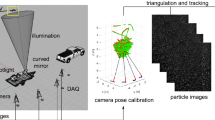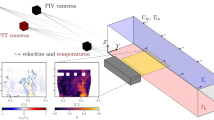Abstract
A method for measuring the two-dimensional distribution of wind velocity vectors near a surface exposed to solar radiation, by tracking brightness temperature images instead of particle images, is proposed. It is based on time-sequential thermography with the algorithm used for particle image velocimetry. This thermal image velocimetry (TIV) was tested on a full-scale building wall covered by polystyrene boards attached side-by-side over a vertically elongated area measuring 22.2 m by 2.73 m. A thermal infrared camera was installed 8 m from the test wall to capture the wall-surface temperature at 30 Hz frequency. A sonic anemometer was also installed 35 mm from the surface used for validation of the TIV. The advection velocity estimated from thermal infrared imagery had a linear relationship with the wind velocity measured by the sonic anemometer, irrespective of the wind speed and direction. This linear slope was multiplied by the advection velocity of the thermal infrared image to rescale it to the wind velocity, and the term ‘TIV velocity’ was then used. A histogram and power spectra of the TIV velocity showed quantitatively good agreement with the velocity measured by the sonic anemometer, except for the high-frequency region of the spectra, where the TIV velocity was overestimated compared with that of the sonic anemometer. The method was also tested on ground covered by artificial turf to demonstrate its application to a horizontal plane with a wider area, extending for more than 80 m by 60 m.










Similar content being viewed by others
References
Adrian RJ (1991) Particle-imaging techniques for experimental fluid mechanics. Annu Rev Fluid Mech 23:261–304
Adrian RJ, Meinhart CD, Tomkins CD (2000) Vortex organization in the outer region of the turbulent boundary layer. J Fluid Mech 422:1–54
Christen A, Voogt JA (2009) Linking atmospheric turbulence and surface temperature fluctuations in a street canyon. In: Proc 7th international conference on urban climate, Yokahama, Japan
Christen A, Garai A, Inagaki A, Kleissl J, Meier F, Scherer D, Vogt R, Voogt JA (2011) Mapping coherent structures responsible for heat exchange between land surfaces and atmosphere using time-sequential thermography. In: Proc coherent flow structures in geophysical flows at Earth’s surface, Burnaby, BC, Canada
Christen A, Meier F, Scherer D (2012) High-frequency fluctuations of surface temperatures in an urban environment. Theor Appl Climatol 108:301–324
Coceal O, Dobre A, Thomas TG, Belcher SE (2007) Structure of turbulent flow over regular arrays of cubical roughness. J Fluid Mech 589:375–409
Drobinski P, Carlotti P, Newsom RK, Banta RM, Foster RC, Redelsperger JL (2004) The structure of the near-neutral atmospheric surface layer. J Atmos Sci 61:699–714
Garai A, Kleissl J (2011) Air and surface temperature coupling in the convective atmospheric boundary layer. J Atmos Sci (in print). doi:10.1175/JAS-D-11-057.1
Hattori Y, Tsuji T, Nagano Y, Tanaka N (2001) Effects of freestream on turbulent combined-convection boundary layer along a vertical heated plate. Int J Heat Fluid Flow 22:315–322
Hetsroni G, Kowalewski TA, Hu B, Mosyak A (2001) Tracking of coherent thermal structures on a heated wall by means of IR thermography. Exp Fluids 30:286–294
Hoyano A, Asano K, Kanamaru T (1999) Analysis of the sensible heat flux from the exterior surface of buildings using time sequential thermography. Atmos Environ 33:3941–3951
Hommema S, Adrian R (2003) Packet structure of surface eddies in the atmospheric boundary layer. Boundary-Layer Meteorol 106:147–170
Hutchins N, Marusic I (2007) Evidence of very long meandering features in the logarithmic region of turbulent boundary layers. J Fluid Mech 579:1–28
Inagaki A, Kanda M (2010) Organized structure of active turbulence developed over an array of cube within the logarithmic layer of atmospheric flow. Boundary-Layer Meteorol 135:209–228
Kaga A, Inoue Y, Yamaguchi K (1992) Application of a fast algorithm for pattern tracking on airflow measurement. In: Proc 6th international symposium on flow visualization, pp 853–857
Kanda M, Moriwaki R, Kasamatsu F (2004) Large eddy simulation of turbulent organized structure within and above explicitly resolved cubic arrays. Boundary-Layer Meteorol 112:343–368
Katul GG, Schieldge J, Hsieh CI, Vidakovic B (1998) Skin temperature perturbations induced by surface layer turbulence above a grass surface. Water Resour Res 34:1265–1274
Kowalewski TA, Mosyak A, Hetsroni G (2003) Tracking of coherent thermal structures on a heated wall. 2. DNS simulation. Phys Fluids 34:390–396
McNaughton KG, Brunet Y (2002) Townsend’s hypothesis, coherent structures and Monin–Obukhov similarity. Boundary-Layer Meteorol 102:161–175
Meier F, Scherer D, Richters J (2010) Determination of persistence effects in spatio-temporal patterns of upward long-wave radiation flux density from an urban courtyard by means of time-sequential thermography. Remote Sens Environ 114:21–34
Meier F, Scherer D, Richters J, Christen A (2011) Atmospheric correction of thermal-infrared imagery of the 3-D urban environment acquired in oblique viewing geometry. Atmos Meas Tech 4:909–922
Nottrott A, Onomura S, Inagaki A, Kanda M, Kleissl J (2010) Convective heat transfer on leeward building walls in an urban environment: measurements in an outdoor scale model. Int J Heat Mass Transfer 54:3128–3138
Onomura S (2010) Experimental study on thermal boundary layer along a building wall. Master thesis, Department of International Development Engineering, Tokyo Institute of Technology
Patel K, Armaly BF, Chen TS (1998) Transition from turbulent natural convection to turbulent forced convection. J Heat Transf 120(4):1086–1089
Porté-Agel F, Pahlow H, Meneveau C, Parlange MB (2001) Atmospheric stability effect on subgrid-scale physics for large-eddy simulation. Adv Water Res 24:1085–1102
Robinson SK (1991) Coherent motions in the turbulent boundary layer. Annu Rev Fluid Mech 32:519–571
Sugawara H, Narita K, Mikami T (2001) Estimation of effective thermal property parameter on a heterogeneous urban surface. J Meteorol Soc Jpn 79:1169–1181
Takimoto H, Sato A, Barlow JF, Moriwaki R, Inagaki A, Onomura S, Kanda M (2011) Particle image velocimetry measurements of turbulent flow within outdoor and indoor urban scale models and flushing motions in urban canopy layers. Boundary-Layer Meteorol 140:295–314
Taylor GI (1938) The spectrum of turbulence. Proc R Soc Lond A 164:476
Townsend AA (1976) The structure of turbulent shear flow. Cambridge University Press, Cambridge, U.K. 429 pp
Voogt R (2008) Visualisation of turbulent exchange using a thermal camera. In: Proc 18th symposium on boundary layers and turbulence, 9–13 June 2008, Stockholm, Sweden
Voogt JA (2008) Assessment of an urban sensor view model for thermal anisotropy. Remote Sens Environ 112:482–495
Voogt JA, Oke TR (2003) Thermal remote sensing of urban climates. Remote Sens Environ 86:370–384
Watanabe T (2004) Large-eddy simulation of coherent turbulence structures associated with scalar ramps over plant canopies. Boundary-Layer Meteorol 112:307–341
Acknowledgments
This research was financially supported by the Research Program on Climate Change Adaptation (RECCA) and a Grant-in-Aid for Young Scientists (B): 23760454 from the Ministry of Education, Culture, Sports, Science, and Technology, Japan.
Author information
Authors and Affiliations
Corresponding author
Rights and permissions
About this article
Cite this article
Inagaki, A., Kanda, M., Onomura, S. et al. Thermal Image Velocimetry. Boundary-Layer Meteorol 149, 1–18 (2013). https://doi.org/10.1007/s10546-013-9832-z
Received:
Accepted:
Published:
Issue Date:
DOI: https://doi.org/10.1007/s10546-013-9832-z




